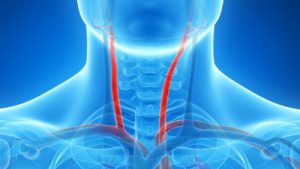 About the Carotid Artery
About the Carotid Artery
The carotid arteries are the major blood vessels that supply blood to the neck, brain, and face. If these arteries become blocked for any reason, it could lead to a deadly stroke. The left and right carotid arteries run through the neck, leading up to the brain. In the neck, each carotid artery branches into two divisions. The internal carotid artery which supplies blood to the brain, and the external carotid artery which supplies blood to the face and neck. The carotid arteries consist of three layers of tissues, namely, intima (innermost layer), media (middle layer), and adventitia (outermost layer).
Carotid Artery Disease
Carotid artery disease, also known as carotid stenosis, occurs when fatty deposits cause a blockage, thereby decreasing blood flow. Such blockages increase the risk of stroke.
The first indication of a carotid artery complication may be a stroke or a transient ischemic attack (TIA). Signs and symptoms of a stroke include:
- Sudden numbness
- Trouble speaking and understanding
- Trouble with sight in one or both eyes
- Severe headaches with no traceable cause
- Inability to move one or more limbs
Risk Factors and Likely Causes of Carotid Artery Disease
- High blood pressure
- High cholesterol levels
- Diabetes
- Sedentary lifestyle
- Age 55 years and above
- Smoking
- Family history of atherosclerosis
- Obesity
- Sleep apnea
Screening and Testing for Carotid Artery Disease
We carry out screening and testing for various ailments, including carotid artery disease and other associated conditions. Such tests are aimed at diagnosing early signs of damage. One standard test is listening to the arteries on the neck for a sound called a bruit. If a bruit is heard, this means that your arteries could be narrowing due to clogging.
Additional tests which might also need to be carried out by our staff include:
- Carotid Ultrasound: This test utilizes sound waves to determine the flow and pressure of blood in the vessels.
- CT Scan of The Head: A CT scan of the head captures the brain tissue’s images to detect any abnormalities or damages.
- Magnetic Resonance Angiography: In this test, three-dimensional photos of the neck and brain are taken with a high-powered magnet. This test makes use of contrast.
- MRI Scan: An MRI (Magnetic Resonance Imaging) scan of the head uses contrast to capture detailed images of the brain.
- Cerebral Angiography: This procedure is quite invasive in nature. A thin, flexible tube known as a catheter is inserted into the carotid artery. A dye is then injected, after which an X-ray is done to detect any anomalies.
Before a meeting with one of our highly trained doctors, there are some questions which you may be asked in order to help get a background of your lifestyle and overall health.
You may be asked the following:
- Do you smoke?
- What is your alcohol consumption rate?
- How often do you exercise?
- Have you ever been diagnosed with any other medical conditions?
- How long have you been experiencing symptoms?
How Can Carotid Disease Be Prevented?
Carotid disease, or carotid stenosis, is not a disease transmitted via air, physical contact, or other transmission routes. However, changes in one’s lifestyle can reduce the risk of falling victim to carotid stenosis.
Here are some ways to reduce the risk significantly:
- Reducing or quitting smoking puts you at less risk than someone who smokes.
- Regular physical activity, especially cardiovascular workouts, can drastically improve blood pressure and overall heart function.
- Maintaining a healthy weight for your age reduces your risk of developing carotid artery disease.
If you are experiencing any of the above symptoms or possess any of the above-mentioned risk factors, please have your screening done as soon as possible.
